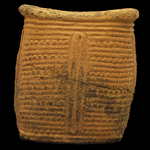Bura Terracotta Head Rest, 3rd Century CE - 11th Century CE
Terracotta
4.5 x 5
SK.067 (LSO)
This sculptural object is in fact a secular piece, which has been attributed to one of Africa’s most inscrutable peoples, the Bura. It is evidently a headrest, and is the...
This sculptural object is in fact a secular piece, which has been attributed to one of Africa’s most inscrutable peoples, the Bura. It is evidently a headrest, and is the first such piece that we have seen. It is a roughly quadrangular piece of sculpted clay, formed from interlocking blocks that have been joined at the edges. There is a central aperture that runs the length of the piece, which appears solid from front and back. The entire surface is covered with low-relief hatching and impressed marks, along with two piercings above the central aperture.
The Bura are a true paradox: almost nothing is known of this shadowy Nigerian/Malian group. They appear to have originated in the first half of the first millennium AD, although the only archaeologically-excavated site (Nyamey) dates between the 14th and 16th centuries. They are contemporary with the Djenne Kingdom, the Koma, the Teneku and a satellite culture known as the Inland Niger Delta, and, like them, have extensive ceramic and stone sculptural traditions.
The Bura were sedentary agriculturists who buried their dead in tall, conical urns that were often decorated with incisions, and sometimes surmounted by small figures. Their best-known art form is radically reductivist anthropomorphic stone statues, with heads rendered as squares, triangles and ovals, with the body suggested by a columnar, monolithic shape beneath. This form finds fuller expression in phallomorphic objects that may have been staffs, perhaps regalia pertaining to leaders. Complex ceramic heads are also known, with incised decoration and variable treatment of facial proportions and features. There are a few very rare equestrian figures: these bear some resemblance to Djenne pieces.
The social role of these figures is uncertain. Equestrian figures probably represent high status individuals, and the very few full-body representations of humans may be portraits or ancestor figures. One might expect figures with exaggerated sexual characteristics to be associated with fertility and fecundity, as would any artefact modelled in the shape of pudenda. The one-sided distribution of decoration on staffs and phalluses may suggest that they were designed to be viewed from one angle only – perhaps as adorational pieces.
So far as we are aware, this is a unique piece. This is a striking and attractive piece of ancient art from one of Africa’s great lost civilisations.
The Bura are a true paradox: almost nothing is known of this shadowy Nigerian/Malian group. They appear to have originated in the first half of the first millennium AD, although the only archaeologically-excavated site (Nyamey) dates between the 14th and 16th centuries. They are contemporary with the Djenne Kingdom, the Koma, the Teneku and a satellite culture known as the Inland Niger Delta, and, like them, have extensive ceramic and stone sculptural traditions.
The Bura were sedentary agriculturists who buried their dead in tall, conical urns that were often decorated with incisions, and sometimes surmounted by small figures. Their best-known art form is radically reductivist anthropomorphic stone statues, with heads rendered as squares, triangles and ovals, with the body suggested by a columnar, monolithic shape beneath. This form finds fuller expression in phallomorphic objects that may have been staffs, perhaps regalia pertaining to leaders. Complex ceramic heads are also known, with incised decoration and variable treatment of facial proportions and features. There are a few very rare equestrian figures: these bear some resemblance to Djenne pieces.
The social role of these figures is uncertain. Equestrian figures probably represent high status individuals, and the very few full-body representations of humans may be portraits or ancestor figures. One might expect figures with exaggerated sexual characteristics to be associated with fertility and fecundity, as would any artefact modelled in the shape of pudenda. The one-sided distribution of decoration on staffs and phalluses may suggest that they were designed to be viewed from one angle only – perhaps as adorational pieces.
So far as we are aware, this is a unique piece. This is a striking and attractive piece of ancient art from one of Africa’s great lost civilisations.



